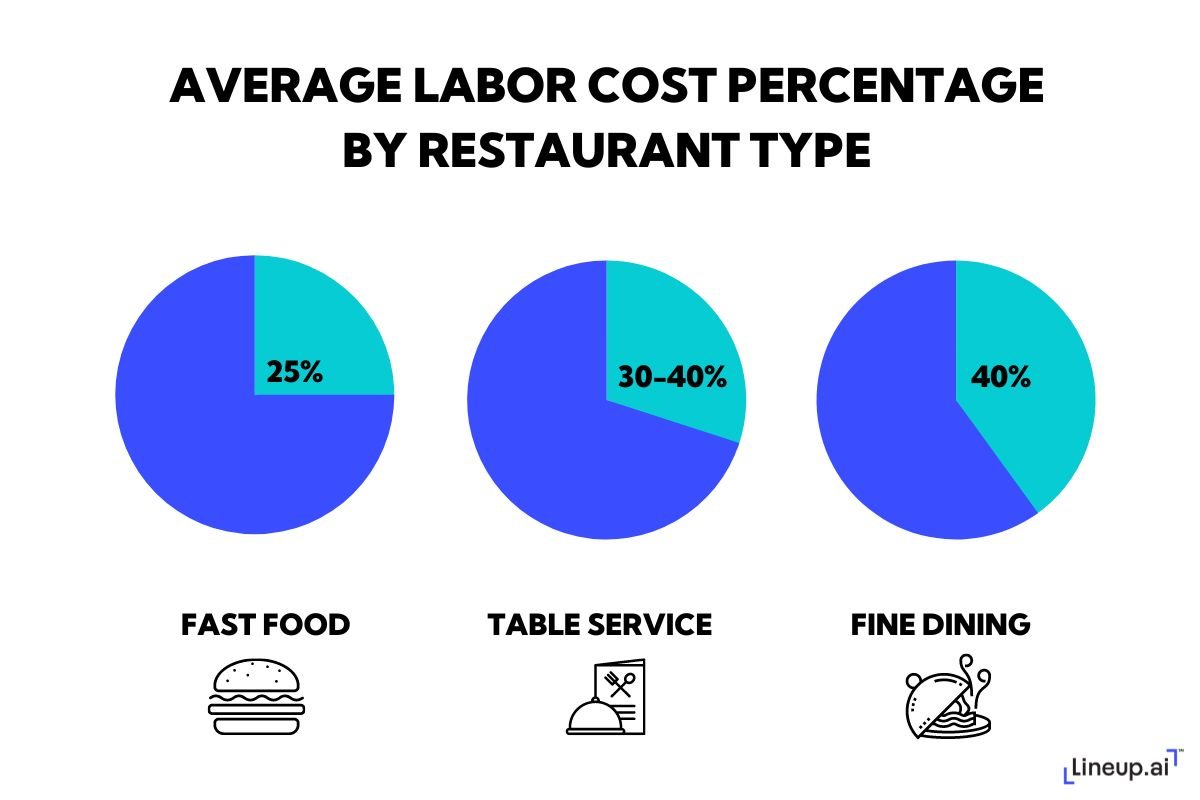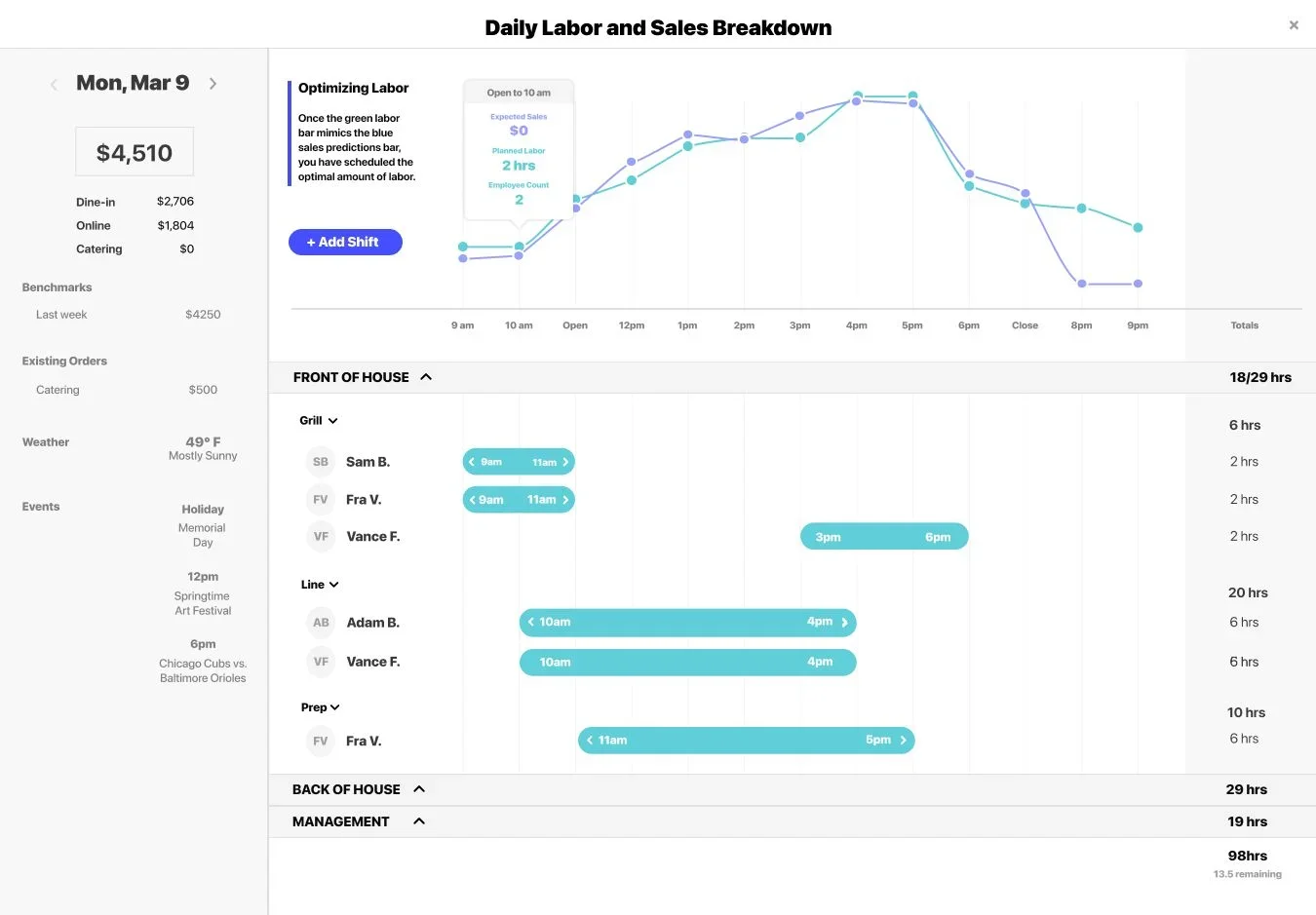Whether you’re opening a new restaurant or looking to improve profit margins for a restaurant that’s been in business for a while, reducing labor costs should be high on your list of priorities.
Why? It’s simple — labor costs can make up a huge percentage of a restaurant’s operating costs. In fact, it’s one of the two main expenses for a restaurant (alongside food costs).
As a general rule of thumb, labor costs for a restaurant should fall between 25% and 40% of the restaurant's total revenue.
Labor costs for different restaurant types vary as follows:
Fast-food restaurants: Typically around 25% of expenses due to faster service, higher profit margins, and less specialized labor.
Table service restaurants: Range from 30% to 40% depending on menu variety and service level.
Fine dining: Labor costs vary but generally tend to be on the higher end of the 30% to 40% scale or even higher, especially for restaurants with complex menus and extensive in-house preparation.
Please note that these figures serve as averages, and individual restaurant labor costs may differ based on various factors.

If you can find a way to control and lower labor costs, you’ll make your restaurant business much more profitable.
Keep on reading to learn about the top six strategies you can use to reduce restaurant labor costs, but first, let's take a look at the factors affecting labor costs in a restaurant.
Factors affecting labor costs in the restaurant industry
The first step in reducing labor costs is to analyze your current labor costs and understand the factors that contribute to them. Some of the factors that impact labor costs in the restaurant industry include minimum wage increases, employee turnover, and rising benefits costs. These factors can make managing labor costs challenging for restaurant owners and managers.
One of the most significant challenges that restaurants face when managing labor costs is scheduling. Many restaurants struggle with overstaffing, which can lead to unnecessary labor costs, and understaffing, which can hurt service quality and customer satisfaction. To optimize scheduling, restaurant owners and managers need to analyze sales data and forecast demand. This helps to ensure that the right number of employees is scheduled at the right time, which can reduce labor costs.
Another factor that contributes to high labor costs in the restaurant industry is employee turnover. High turnover rates can be costly for restaurants, as it takes time and money to train new employees. Employee turnover can be caused by many factors, such as low pay, poor working conditions, or lack of opportunities for advancement. To reduce restaurant employee turnover, restaurant owners and managers need to create a positive work environment, offer competitive pay and benefits, and provide opportunities for growth and development.
Check out our labor cost spreadsheet for restaurants.
Top strategies for reducing restaurant labor costs
Once you have analyzed your labor costs and identified the factors that contribute to them, it's time to implement effective strategies to control labor costs in a restaurant.
1. Minimize overtime
Overtime can be very expensive. Employees covered by the Fair Labor Standards Act need to be paid 1.5 times their regular hourly pay for every hour worked above 40 hours per week.
Excessive overtime not only hurts your restaurant’s profit margins but also has a negative impact on your staff’s morale. Employees that work overtime too often can have reduced performance and experience burnout.
Here are a few things you can do to minimize overtime and mitigate the higher labor cost that comes with it:
- Make overtime an exception – Make sure your employees know that working overtime should be an exception, not the rule. Don’t let overtime become a part of your company culture.
- Set a cap for overtime hours – Decide on the maximum number of overtime hours your employees are allowed to work per hour. Let your entire staff know that they’re not allowed to go over this number.
- Create an overtime policy – To make sure your staff will adhere to your overtime rules, create a documented overtime policy. Within the document, make sure to outline when overtime is allowed, as well as how it’s tracked and paid.
2. Cross-train your staff
If all your staff members only know how to perform one duty each, your overall efficiency will suffer. It might also result in unnecessary overstaffing.
Cross-training involves training both your front-of-house and back-of-house staff to perform tasks that are outside their regular role. For example, training prep cooks to work the grill or training servers to bartend.
Cross-training reduces your reliance on specific employees and ensures that staff members will be able to handle multiple different tasks and roles when needed.
Additionally, on less busy nights, you can have one staff member handle two roles instead of scheduling an additional worker for that shift.
Having cross-trained staff members is also very useful for when one or more staff members call in sick – you’ll always have someone on shift that can replace them.
Finally, cross-trained restaurant employees can help you keep things running smoothly and enable you to provide the same level of service even when a staff member decides to leave.
Here’s how to cross-train your staff successfully:
- Choose the right trainers – It’s crucial that you choose team members who have a deep understanding of your restaurant’s processes and procedures. They should also be patient and ideally have a flair for teaching.
- Use mock scenarios – The best way to make sure your team is cross-trained properly is to put staff members into mock scenarios where you can test their skills.
- Have at least two people trained for each role – You should have at least one trained team member that can step in when one of your employees isn’t available to work a shift.
3. Hire part-time help
If you find yourself paying overtime consistently during busy times of the year, consider hiring seasonal employees or part-time workers to ease the load off of your full-time staff and save money at the same time.
Staffing your time with a few part-time workers allows you to make sure your restaurant is adequately staffed when needed without burdening you with having to keep these workers employed permanently.
In a lot of cases, you’re also not obligated to pay all benefits for part-time workers, which helps to reduce your labor costs further.
Follow these tips when hiring part-time help:
- Define the role clearly – In order to hire the best person for your part-time role, it’s crucial that you define the job clearly. When writing the job description, make sure to outline all the skills and experience required, as well as the duties and responsibilities involved.
- Remember to stay flexible – You will need to be flexible when it comes to part-time workers since they’ll likely have other responsibilities (e.g., students, people working another job, etc.)
- Provide adequate onboarding and training – How successful your new employees will be at performing their duties will largely depend on the onboarding and training you provide. Make sure each new hire is aware of relevant restaurant procedures and best practices and goes through role-specific training.
4. Take advantage of technology
Restaurants have been employing technology for years in an effort to improve efficiency and reduce labor costs.
The use of technology in the restaurant industry is only going to become more prevalent — 50% of US restaurants plan on implementing technology to facilitate process automation in the next two to three years.
Technology enables you to automate some of the repetitive, manual labor your staff does, which in turn helps you lower labor costs.
Here are a few restaurant management software solutions you can implement to reduce labor costs:
- Reservation management system – Implementing a reservation management system will enable guests to see your restaurant’s availability in real-time and reserve a table themselves. This, in turn, will free your staff from having to take reservations by phone, resulting in fewer hours of labor.
- Self-service ordering kiosk – If the style of your restaurant allows for it, a self-service ordering kiosk can allow customers to place their orders themselves instead of having to wait for a staff member to take their order. This speeds up the ordering process and results in less work for your team.
- Restaurant labor forecasting software – Lineup.ai offers AI-powered labor forecasting software designed specifically for restaurants. This software eliminates the need for guesswork when creating labor schedules and sales forecasts. By leveraging historical data, weather patterns, and local events, the system accurately predicts customer demand, enabling restaurants to optimize their labor needs. With the ability to forecast up to four weeks in advance, restaurants can effectively manage and minimize one of their largest expenses by avoiding unnecessary overstaffing.

5. Reduce employee turnover
Employee turnover is a big problem in the hospitality industry, especially considering the current labor shortage.
Additionally, hiring and training employees is very expensive, so if you want to reduce labor costs, you should do whatever you can to reduce restaurant staff turnover.
Here are four things you can do to improve employee retention and experience lower turnover rates at your restaurant:
- Create a healthy work environment – A lot of people leave jobs because of a toxic work environment. To prevent this, you should work on creating a positive workplace culture and providing a healthy work environment for your restaurant staff.
- Check in with team members regularly – You should check in with each team member individually every once in a while to see how they’re doing. Make sure to ask whether they’re happy in their role and if there’s anything you could do to help them feel more satisfied with the work they’re doing.
- Provide career advancement opportunities – If you want to keep more of your employees, you need to provide them with a path for career growth. Additionally, prioritize promoting from within when looking for someone to take on a senior role.
- Conduct exit interviews – When an employee decides to leave, make sure to interview them to understand their reasons for leaving. This will allow you to address issues that might be causing team members to quit.
6. Optimize scheduling
Most restaurants’ employee scheduling causes them to lose money. They either understaff or overstaff shifts frequently, which results in increased labor costs and employee burnout.
Creating an optimal schedule should start with restaurant sales forecasting — you need to have a good idea of how busy your restaurant is going to be at particular times of the day, week, month, and year.
Then, you should use these forecasts to schedule the optimal number of staff members for each shift.
Keep in mind that forecasts based on historical data are not completely accurate since there are a lot of factors that can affect how busy your restaurant is going to be at any given time.
This is where restaurant technology solutions can help. A restaurant sales forecasting software like Lineup.ai can help you create extremely accurate sales forecasts that take into account not just historical sales data, but also weather factors and local event information, road and school closures, and more.
How does restaurant automation reduce labor costs?
Best restaurant automation tools reduce labor costs by streamlining order processing, automating kitchen tasks, optimizing inventory management, and using technology for payment processing, scheduling, and customer service. This can lead to fewer required staff hours and more efficient operations.
Using tools like Lineup.ai, you can significantly reduce labor costs by streamlining various aspects of restaurant operations. Lineup.ai is an example of an artificial intelligence (AI)-driven software designed for the restaurant industry.
Staff Scheduling Optimization
Lineup.ai uses AI algorithms to analyze historical data, seasonal trends, and sales forecasts to create optimized staff schedules. By aligning labor resources with actual demand, it minimizes overstaffing and reduces labor costs while ensuring that restaurants have the right number of employees during peak hours.
Labor Cost Monitoring
The platform allows restaurant managers to monitor labor costs in real-time. It provides insights into labor expenses, helping to identify cost-saving opportunities and make on-the-fly adjustments to staffing levels as needed.
Reduce restaurant labor costs to boost profitability
A big part of effective restaurant management involves knowing how to reduce labor costs to improve a restaurant’s profit margins.
Pick one of the strategies we outlined above and get started on implementing it to reduce labor costs at your restaurant. Once you see success with one strategy, work on implementing a second one for even more labor cost savings.
Pro tip: Check out our free restaurant forecast calculator.
Further read:

Boris Mustapic is a content marketer with a decade of experience in the digital marketing industry. He specializes in helping B2B SaaS companies drive growth through strategic, product-led content marketing.
More about the author